Every once in a while a kit manufacturer produces a kit of a subject which makes one wonder how everyone else managed to ignore it for so long. Profil 24's Lotus Elite does just that.
The Elite was Colin Chapman's typically original approach to low cost, low volume car production with the extra desirability of "added lightness" and was conceived to lift Lotus out of the kit-car market into the world of specialist sports car manufacture. It incorporated many advanced features for a British car of 1957 vintage, the most innovative of which was the use of glass reinforced polyester to form both the body and chassis elements, the engine mounts and suspension points being bonded in to the grp shell.
At a stroke this eliminated the weight and expense of a complete tubular chassis and allowed the use of cheap moulds instead of prohibitively expensive press-forming tools for the bodywork. Coupled with an overhead camshaft engine, disc brakes on all four wheels and fully independent suspension, the Elite was a milestone in automotive
engineering. As one of the prettiest and best handling cars of it's day it set the standards with which the company is still identified and just as today, it didn't take the racing fraternity long to catch on.
In the hands of drivers such as Jim Clark, Sir John Whitmore, Colin Chapman, Ian Walker, Les Leston, Peter Lumsden and Peter Riley, the Elite had class wins from Le Mans to the Nurburgring and countless victories at club level at home and abroad.
Production came to an end in 1963 and although less than a thousand units were produced the Elite had won itself a place in the hearts of racecar enthusiasts the world over.
|
The kit
We have Profil to thank for filling this void in 1/24 scale racing history and it is with some relief that I have to say that they have done this pretty admirably.
The model isn't faultless in concept or execution but it's more than adequate in providing a base around which an excellent replica can be built.
I have not built mine yet so these are first impressions and obviously I cannot comment on the fit of all parts except to say that I have seen nothing which would cause any decent modeler to self destruct.
|
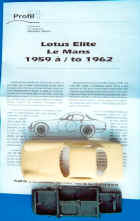
|
|
Overview
The kit comes decently packed in a sturdy box and provides for five different cars to be built, both with and without bumpers and sidescreen frames and in left and right hand versions. I'm sure a road car could be easily built also. Everything is provided to produce a convincing curbside model which, as I get older and my collection of unbuilt kits expands, presents an ever more attractive format!.
|
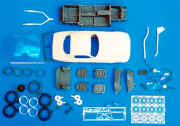
|
All major parts are cast in resin with metal used only for the wheels, axles and p/e fret. This is perhaps the most contentious area but more on that later.
|
Body
The body is cleanly moulded in one piece in a good quality, light coloured resin. There is very little flash and the mould separation lines are confined to the underside of the sills, making cleanup easy. Panel lines are neat and not overdone. They should look very convincing under a coat of paint.
The overall shape and lovely lines of the Elite are generally well captured although comparison with drawings (not always reliable) and scaled photographs shows a couple of suspect areas.
|

|
|

|
I don't think that the top edge of the windshield has enough curvature in plan view whilst the lower edge has too much (about 2 or 3 mm.). This could be corrected by a skilled modeler but I'm sure would only be detectable in a side by side comparison.
Other minor points: the top line of the front wing appears to curve down a shade too sharply to the headlight and the front windscreen pillars are a little too thick. Also the leading edge of the quarter light should be straight initially and not a continuous curve as depicted. This is not easy to correct if using the p/e frame as that is curved to match the body also.
Finally, the curvature of the top leading edge of the door is a little too acute. It should curve more gently.
Unfortunately, although correctly portrayed, the inner door panels are moulded en situ whereas in this scale, I would prefer them too be separate items to ease painting.
|
Chassis
This is a simplified one-piece moulding in a dark grey resin. It fits the body with only a little tweaking here and there and should present no major problem.
|
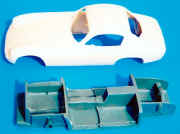
|
Ancillaries
These are moulded in the same resin as the chassis in the main, although a few are in the lighter resin for no apparent reason. Moulding quality is very good, however flash is more prevalent here, needing more cleanup.
It is in this area that I feel the kit suffers a little. Chromed or aluminium parts on the real car would be better produced in white metal, enabling them to be polished rather than painted and hence more realistic. The spare wheel, carried horizontally behind the seats is a one-piece resin casting, which will be difficult to make to look like the main wheels. An extra wheel would have been superior. I cannot for the life of me understand why the steering wheel was cast complete in resin. P/e spokes would have been far superior. Also, the spokes are the wrong pattern for a standard wheel, having holes instead of the usual radial tapered slots. Both types could have been provided at no cost on the p/e fret.
A set of small, clear mouldings is provided for the marker lights.
I could not find any rear view mirror.
|
Wheels and Tyres
Wheels are d.i.y. style with beautifully turned outer rims, resin inners and p/e spokes. The latter are a shade thicker than necessary but are still pretty good. Tyres are a soft rubber and nicely treaded albeit with a large moulding tag.
P/e fret
This is well done and includes w/screen side frames, door catches, windscreen wiper, dashboard, bonnet straps and grille surround. As befits the scale, it is double etched to give added detail.
|
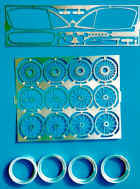
|
Vac-form
Windscreens and headlight glasses are vac-formed and are nicely clear.
|
Decals
Decals are beautifully printed with good, vibrant colours and clean whites. Carrier film overlap is minimal and the set appears very comprehensive including markings for two blue cars, two white cars and a dark green car. A second tiny sheet provides highly detailed instrument faces.
|
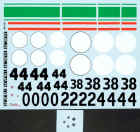
|
|
Instructions
A four page A4 booklet in English and French gives a brief history, marking guide and full building instructions, the latter mainly of the pictorial variety.
All versions are covered but no specific body colours are recommended. I sympathize here as this kind of information can be a minefield. Thus you can use your own ideas for British Racing Green and Lt. French Blue. And don't think that all whites are the same!
|
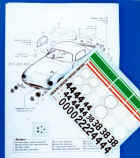
|
Summary
This is the first kit I have seen from Profil 24 and I can thoroughly recommend it to anyone with a bit of experience of resin kits. It will not build like a plastic kit but there is enough raw material to produce a very satisfying model. A fair bit of work could produce a stunning replica and with a little imagination and skill, few of the problems are insurmountable.
The choice of subject is both brave and imaginative and I commend Profil for their refreshing approach. Many alternative colour schemes spring to mind, most being fairly simple to realise which is an added bonus.
Yes, I do like this kit. In fact, I love it and if I hadn't got two other projects near completion, I'd be building it now. The only way to thank Profil is to support their efforts. I hope this is a success for them. Smiley faces all round!
|